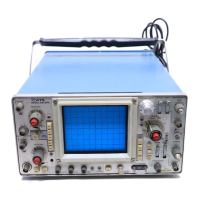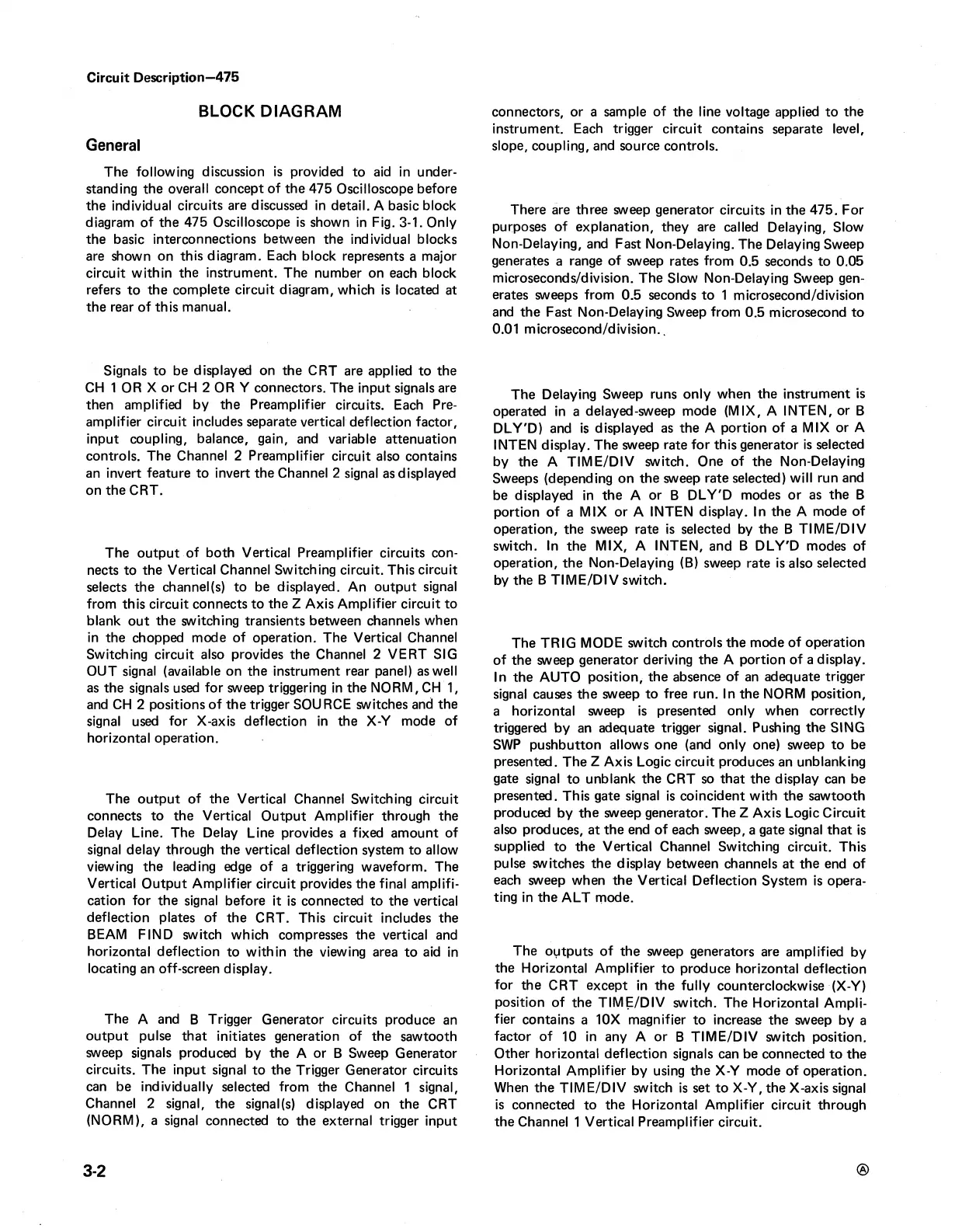Circuit Description—475
BLOCK DIAGRAM
General
The following discussion is provided to aid in under
standing the overall concept of the 475 Oscilloscope before
the individual circuits are discussed in detail. A basic block
diagram of the 475 Oscilloscope is shown in Fig. 3-1. Only
the basic interconnections between the individual blocks
are shown on this diagram. Each block represents a major
circuit within the instrument. The number on each block
refers to the complete circuit diagram, which is located at
the rear of this manual.
Signals to be displayed on the CRT are applied to the
CH 1 OR X or CH 2 OR Y connectors. The input signals are
then amplified by the Preamplifier circuits. Each Pre
amplifier circuit includes separate vertical deflection factor,
input coupling, balance, gain, and variable attenuation
controls. The Channel 2 Preamplifier circuit also contains
an invert feature to invert the Channel 2 signal as displayed
on the CRT.
The output of both Vertical Preamplifier circuits con
nects to the Vertical Channel Switching circuit. This circuit
selects the channel(s) to be displayed. An output signal
from this circuit connects to the Z Axis Amplifier circuit to
blank out the switching transients between channels when
in the chopped mode of operation. The Vertical Channel
Switching circuit also provides the Channel 2 VERT SIG
OUT signal (available on the instrument rear panel) as well
as the signals used for sweep triggering in the NORM, CH 1,
and CH 2 positions of the trigger SOURCE switches and the
signal used for X-axis deflection in the X-Y mode of
horizontal operation.
The output of the Vertical Channel Switching circuit
connects to the Vertical Output Amplifier through the
Delay Line. The Delay Line provides a fixed amount of
signal delay through the vertical deflection system to allow
viewing the leading edge of a triggering waveform. The
Vertical Output Amplifier circuit provides the final amplifi
cation for the signal before it is connected to the vertical
deflection plates of the CRT. This circuit includes the
BEAM FIND switch which compresses the vertical and
horizontal deflection to within the viewing area to aid in
locating an off-screen display.
The A and B Trigger Generator circuits produce an
output pulse that initiates generation of the sawtooth
sweep signals produced by the A or B Sweep Generator
circuits. The input signal to the Trigger Generator circuits
can be individually selected from the Channel 1 signal,
Channel 2 signal, the signal(s) displayed on the CRT
(NORM), a signal connected to the external trigger input
connectors, or a sample of the line voltage applied to the
instrument. Each trigger circuit contains separate level,
slope, coupling, and source controls.
There are three sweep generator circuits in the 475. For
purposes of explanation, they are called Delaying, Slow
Non-Delaying, and Fast Non-Delaying. The Delaying Sweep
generates a range of sweep rates from 0.5 seconds to 0.05
microseconds/division. The Slow Non-Delaying Sweep gen
erates sweeps from 0.5 seconds to 1 microsecond/division
and the Fast Non-Delaying Sweep from 0.5 microsecond to
0.01 microsecond/division..
The Delaying Sweep runs only when the instrument is
operated in a delayed-sweep mode (M IX, A INTEN, or B
DLY'D) and is displayed as the A portion of a MIX or A
INTEN display. The sweep rate for this generator is selected
by the A T IM E/DIV switch. One of the Non-Delaying
Sweeps (depending on the sweep rate selected) will run and
be displayed in the A or B DLY'D modes or as the B
portion of a M IX or A INTEN display. In the A mode of
operation, the sweep rate is selected by the B TIM E /D IV
switch. In the M IX, A INTEN, and B DLY'D modes of
operation, the Non-Delaying (B) sweep rate is also selected
by the B TIM E /DIV switch.
The TRIG MODE switch controls the mode of operation
of the sweep generator deriving the A portion of a display.
In the AUTO position, the absence of an adequate trigger
signal causes the sweep to free run. In the NORM position,
a horizontal sweep is presented only when correctly
triggered by an adequate trigger signal. Pushing the SING
SWP pushbutton allows one (and only one) sweep to be
presented. The Z Axis Logic circuit produces an unblanking
gate signal to unblank the CRT so that the display can be
presented. This gate signal is coincident with the sawtooth
produced by the sweep generator. The Z Axis Logic Circuit
also produces, at the end of each sweep, a gate signal that is
supplied to the Vertical Channel Switching circuit. This
pulse switches the display between channels at the end of
each sweep when the Vertical Deflection System is opera
ting in the ALT mode.
The outputs of the sweep generators are amplified by
the Horizontal Amplifier to produce horizontal deflection
for the CRT except in the fully counterclockwise (X-Y)
position of the TIM E/D IV switch. The Horizontal Ampli
fier contains a 10X magnifier to increase the sweep by a
factor of 10 in any A or B TIM E/D IV switch position.
Other horizontal deflection signals can be connected to the
Horizontal Amplifier by using the X-Y mode of operation.
When the TIM E/D IV switch is set to X-Y, the X-axis signal
is connected to the Horizontal Amplifier circuit through
the Channel 1 Vertical Preamplifier circuit.
®
3-2

